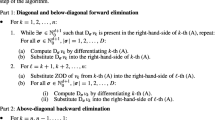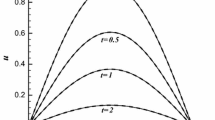Abstract
In this paper, a novel lattice Boltzmann (LB) equation model is proposed to solve the fourth order nonlinear partial differential equation (NPDE). Different from existing LB models, a source distribution function is introduced to remove some unwanted terms in the nonlinear part of the equation. Hereby, the equilibrium distribution function is designed to follow the rule of Chapman–Enskog (C–E) analysis. Through the C–E procedure, the fourth order NPDE can be recovered perfectly from the proposed LB model. A series of numerical experiments have been carried out to solve some widely studied fourth order NPDEs, including the Kuramoto–Sivashinsky equation, Cahn–Hilliard equation with double-well potential and a fourth order diffuse interface model with Peng–Robinson equation of state. Numerical results show that the performance of the present LB model is much better than other existing LB models.








Similar content being viewed by others
References
Aidun, C., Clausen, J.: Lattice Boltzmann method for complex flows. Ann. Rev. Fluid Mech. 42, 439–372 (2010)
Allen, S.M., Cahn, J.W.: Mechanisms of phase transformations within the miscibility gap of Fe-rich Fe–Al alloys. Acta Metall. 24, 425–437 (1976)
Anderson, D.M., McFadden, G.B., Wheeler, A.A.: Diffuse-interface methods in fluid mechanics. Ann. Rev. Fluid Mech. 30, 139–165 (1998)
Breure, B., Peters, C.J.: Modeling of the surface tension of pure components and mixtures using the density gradient theory combined with a theoretically derived influence parameter correlation. Fluid Phase Equil. 334, 96–189 (2012)
Cahn, J.W., Hilliard, J.E.: Free energy of a non-uniform system free energy. J. Chem. Phys. 28, 258–267 (1958)
Chai, Z.H., Shi, B.C., Guo, Z.L.: A multiple-relaxation-time Lattice Boltzmann model for general nonlinear anisotropic convection–diffusion equations. J. Sci. Comput. 69, 355–390 (2016)
Chai, Z.H., He, N.Z., Guo, Z.L., Shi, B.C.: Lattice Boltzmann model for high-order nonlinear partial differential equations. Phys. Rev. E 97, 013304 (2018)
Chai, Z., Shi, B., Zheng, L.: A unified lattice Boltzmann model for some nonlinear partial differential equations. Chaos Solitons Fractals 36, 874–882 (2008)
Chen, L., Kang, Q., Tang, Q., et al.: Pore-scale simulation of multicomponent multiphase reactive transport with dissolution and precipitation. Int. J Heat Mass Trans. 85, 935–949 (2015)
Chen, L.J., Ma, C.F.: A lattice Boltzmann model with an amending function for simulating nonlinear partial differential equations. Chin. Phys. B 19, 010504 (2010)
Chen, S., Doolen, G.: Lattice Boltzmann method for fluid flows. Ann. Rev. Fluid Mech. 30, 329–364 (1998)
Chiu, P.H., Lin, Y.T.: A conservative phase field method for solving incompressible two-phase flows. J. Comput. Phys. 230, 185–204 (2011)
Fan, X., Kou, J., Qiao, Z., Sun, S.: A componentwise convex splitting scheme for diffuse interface models with van der Waals and Peng–Robinson equations of state. SIAM J. Sci. Comput. 39, B1–B28 (2017)
Geier, M., Fakhari, A., Lee, T.: Conservative phase-field lattice Boltzmann model for interface tracking equation. Phys. Rev. E 91, 063309 (2015)
Gunstensen, A.K., Rothman, D.H., Zaleski, S., Zanetti, G.: Lattice Boltzmann model of immiscible fluids. Phys. Rev. A 43, 4320–4327 (1991)
Guo, Z., Shu, C.: Lattice Boltzmann Method and its Applications in Engineering. World Scientific Publishing, Singapore (2013)
Guo, Z., Zheng, C., Zhao, T.: A lattice BGK scheme with general propagation. J. Sci. Comp. 16(4), 569–585 (2001)
Kim, J.: Phase-field models for multi-component fluid flows. Commun. Comput. Phys. 12, 613–661 (2012)
Kou, J., Sun, S.: Unconditionally stable methods for simulating multi-component two-phase interface models with Peng–Robinson equation of state and various boundary conditions. J. Comput. Appl. Math. 291, 158–182 (2016)
Kou, J., Sun, S., Wang, X.: Linearly decoupled energy-stable numerical methods for multicomponent two-phase compressible flow. SIAM J. Numer. Anal. 56, 3219–3248 (2018)
Kou, J., Sun, S., Wang, X.: A novel energy factorization approach for the diffuse-interface model with Peng–Robinson equation of state. SIAM J. Sci. Comput. 42, B30–B56 (2020)
Ladd, A.: Numerical simulations of particle suspensions via a discretized Boltzmann equation. Part 2. Numerical results. J. Fluids Mech. 271, 311 (1994)
Ladd, A., Verberg, R.: Lattice-Boltzmann simulations of particle-fluid suspensions. J. Stat. Phys. 104, 1191–1251 (2001)
Lai, H., Ma, C.: Lattice Boltzmann method for the generalized Kuramoto–Sivashinsky equation. Phys. A (Amsterdam) 388, 1405–1412 (2009)
Lai, H., Ma, C.: The lattice Boltzmann model for the second-order Benjamin–Ono equations. J. Stat. Mech. 2010, P04011 (2010)
Lee, T., Lin, C.L.: A stable discretization of the lattice Boltzmann equation for simulation of incompressible two-phase flows at high density ratio. J. Comput. Phys. 206, 16–47 (2005)
Li, H., Ju, L., Zhang, C., Peng, Q.: Unconditionally energy stable linear schemes for the diffuse interface model with Peng–Robinson equation of state. J. Sci. Comput. 75, 993–1015 (2018)
Li, Q., Luo, K.H., Gao, Y.J., He, Y.L.: Additional interfacial force in lattice Boltzmann models for incompressible multiphase flows. Phys. Rev. E 85, 026704 (2012)
Li, Q., Luo, K., Kang, Q., He, Y., et al.: Lattice Boltzmann methods for multiphase flow and phasechange heat transfer. Progr. Energy Combust. 52, 62–105 (2016)
Liang, H., Shi, B., Guo, Z.L., Chai, Z.H.: Phase-field-based multiple-relaxation-time lattice Boltzmann model for incompressible multiphase flows. Phys. Rev. E 89, 053320 (2014)
Liu, H., Kang, Q., Leonardi, C.R., et al.: Multiphase lattice Boltzmann simulations for porous media applications. Comput. Geosci. 20, 777–805 (2014)
Otomo H.,: Lattice Boltzmann models for higher-order partial differential equations. Ph.D Thesis, Tufts University (2019)
Peng, Q.: A convex-splitting scheme for a diffuse interface model with Peng–Robinson equation of state. Adv. Appl. Math. Mech. 9, 1162–1188 (2017)
Qiao, Z., Sun, S.: Two-phase fluid simulation using a diffuse interface model with Peng–Robinson equation of state. SIAM J. Sci. Comput. 36, B708–B728 (2014)
Qiao, Z., Yang, X., Zhang, Y.: Mass conservative lattice Boltzmann scheme for a three-dimensional diffuse interface model with Peng-Robinson equation of state. Phys. Rev. E 98(2), 023306 (2018)
Shan, X., Chen, H.: Lattice Boltzmann model for simulating flows with multiple phases and components. Phys. Rev. E 47, 1815–1819 (1993)
Shen, J., Yang, X.: A phase-field model and its numerical approximation for two-phase incompressible flows with different densities and viscosities. SIAM J. Sci. Comput. 32, 1159–1179 (2010)
Shi, B., Guo, Z.: Lattice Boltzmann model for nonlinear convection-diffusion equations. Phys. Rev. E 79, 016701 (2009)
Succi, S.: A note on the lattice Boltzmann versus finite-difference methods for the numerical solution of the Fishers equation. Int. J. Mod. Phys. C 25, 1340015 (2014)
Wang, Y., Shu, C., Huang, H.B., Teo, C.J.: Multiphase lattice Boltzmann flux solver for incompressible multiphase flows with large density ratio. J. Comput. Phys. 280, 404–423 (2015)
Wang, Y., Shu, C., Shao, J.Y., Wu, J., Niu, X.D.: A mass-conserved diffuse interface method and its application for incompressible multiphase flows with large density ratio. J. Comput. Phys. 290, 336–351 (2015)
Yan, G., Zhang, J.: A higher-order moment method of the lattice Boltzmann model for the Korteweg–de Vries equation. Math. Comput. Simul. 79, 1554–1565 (2009)
Yan, G.W.: A lattice Boltzmann equation for waves. J. Comput. Phys. 161, 61–69 (2000)
Yang, K., Guo, Z.: Lattice Boltzmann method for binary fluids based on mass-conserving quasi-incompressible phase-field theory. Phys. Rev. E 93, 043303 (2016)
Ye, L., Yan, G., Li, T.: Numerical method based on the lattice Boltzmann model for the Kuramoto–Sivashinsky equation. J. Sci. Comput. 49, 195–210 (2011)
Yu, X.M., Shi, B.C.: A lattice Bhatnagar–Gross–Krook model for a class of the generalized Burgers equations. Chin. Phys. 15, 1441–1449 (2006)
Zhang, Z., Qiao, Z.: An adaptive time-stepping strategy for the Cahn–Hilliard equation. Commun. Comput. Phys. 11, 1261–1278 (2012)
Zhang, T., Shi, B.C., Guo, Z.L., et al.: General bounce-back scheme for concentration boundary condition in the lattice Boltzmann method. Phys. Rev. E 85, 016701 (2012)
Zheng, L., Zheng, S., Zhai, Q.: Lattice Boltzmann equation method for the Cahn–Hilliard equation. Phys. Rev. E 91, 013309 (2015)
Zu, Y.Q., He, S.: Phase-field-based lattice Boltzmann model for incompressible binary fluid systems with density and viscosity contrasts. Phys. Rev. E 87, 043301 (2013)
Acknowledgements
The authors are grateful to the referees for careful reading and constructive comments that improved the quality of this paper. The authors also appreciate the valuable discussions with Prof. Shuyu Sun in King Abdullah University of Science and Technology. Z. Qiao’s work is partially supported by Hong Kong Research Council GRF Grant 15325816 and the Hong Kong Polytechnic University internal research fund G-UAEY. X. Yang’s work is partially supported by the Natural Science Foundation of China (Grant No. 11802090) and the Hong Kong Polytechnic University Postdoctoral Fellowships Scheme 1-YW1D.
Author information
Authors and Affiliations
Corresponding author
Additional information
Publisher's Note
Springer Nature remains neutral with regard to jurisdictional claims in published maps and institutional affiliations.
Appendix
Appendix
The definition of parameters a(T) and b are given by the following mixing rules
where \(y_{i}=n_{i}/n\) is the mole fraction of component i, \(k_{ij}\) is the binary interaction coefficient of Peng–Robinson EOS, which is usually computed from experimental correlation. The Peng–Robinson parameters \(a_i\) and \(b_i\) for pure-substance component i can be derived from the critical properties of the particular species as follows:
Here, \(T_{c_i}\) and \(P_{c_i}\) represent the critical temperature and the critical pressure of a pure substance, respectively. The parameter \(m_i\) has the following relations with the acentric parameter \(\omega _i\):
The acentric parameter \(\omega _i\) can be computed by using critical temperature \(T_{c_{i}}\), critical pressure \(P_{c_{i}}\) and the normal boiling point \(T_{b_{i}}\):
The cross influence parameter \(c_{ij}\) can be obtained by using the modified geometric mean rule
where \(\beta _{ij}\) represents the binary interaction coefficient for the influence parameter. Its value is usually assumed to be zero in most engineering practice. \(c_i\) is the pure component influence parameter, which is related to the Peng–Robinson parameters \(a_i\) and \(b_i\) by [4]
Here, \(m_{1,i}^c\) and \(m_{2,i}^c\) denote the coefficients which can be related to the acentric factor \(\omega _i\) by
Rights and permissions
About this article
Cite this article
Qiao, Z., Yang, X. & Zhang, Y. A Novel Lattice Boltzmann Model for Fourth Order Nonlinear Partial Differential Equations. J Sci Comput 87, 51 (2021). https://doi.org/10.1007/s10915-021-01471-6
Received:
Revised:
Accepted:
Published:
DOI: https://doi.org/10.1007/s10915-021-01471-6




